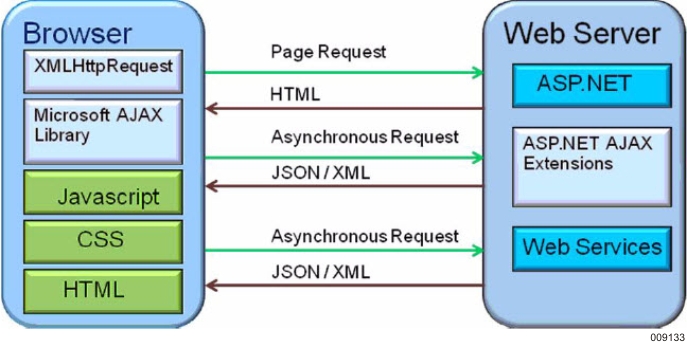AJAX is an abbreviation for Asynchronous JavaScript And XML. It is a technology that allows you to identify elements on a web page that can be updated independently of other elements on the same page, without causing the whole page to be updated when the browser end user interacts with the controls. This is often referred to as partial page rendering and results in a more responsive user interface and the elimination of the Browser refresh between transactions
AJAX enabled controls communicate directly with the web server as an asynchronous background activity. In an AJAX environment, the client side (the browser), and the server side must be AJAX capable to handle partial rendering of elements or controls on a web page.
The diagram below highlights the various components on the Browser and Web Server that participate in an AJAX capable environment. When the initial page request from the Browser is sent, the server sends the HTML for the entire page. Subsequent requests from the Browser are sent asynchronously using the XMLHttpRequest object in conjunction with the AJAX script library. Only the required data for the partial page update is sent and received, which reduces the amount of data transferred between the Browser and the Web Server. The data is typically exchanged using XML format.
However, the JavaScript Object Notation is sometimes used to reduce the data size even further.
The implementation for AJAX Support in the Client Tools ASP.NET Generator concentrates on enabling the CEWebFormRenderer control to be capable in participating
on a WebForm that includes AJAX UpdatePanels. This means that the CEWebFormRenderer can be placed on a page inside an UpdatePanel and the surrounding controls on the form is affected when the user interacts with the AB Suite system through the form displayed by the CEWebFormRenderer.
AJAX enabling the Web Form Renderer Control means the customer is able to create AJAX-based web applications in which they include the Web Form Renderer Control for accessing EAE or AB Suite host applications. The customer can decide if and when they want to introduce AJAX in their ASP.NET Web Application by including an AJAX ScriptManager and AJAX UpdatePanel(s) on the web page hosting the Renderer Control. The benefit to the customer of an AJAX enabled Web Form Renderer is a flicker free experience for their browser end users.
Depending on the ASP.NET Web Application, a reduction in the number of bytes sent from the web server could be another benefit. However, when introducing AJAX on a web page using the Microsoft ASP.NET AJAX implementation, as an overhead, a JavaScript library of about 25,000 bytes is sent to the browser. This might be cached in the browser depending on the browser settings. The reduction of bytes might be experienced on round trips to the web server after the first page, which is always a full download. The reduction depends on whether the web page includes other controls in addition to the Renderer control. When the Renderer control is the only control on a page, the reduction is minimal. However, when the page includes other controls and only the Renderer control is refreshed from the server, the reduction is measurable.
